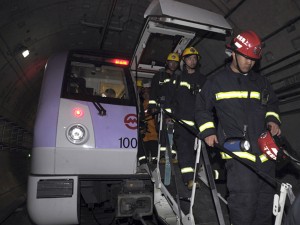Filipino among 271 injured in China metro crash

Rescue workers walk out from the emergency exit of a train involved in a collision in Shanghai on Tuesday. AP photo
SHANGHAI—Two metro trains collided in Shanghai on Tuesday, injuring more than 270 people including a Filipino, the city government said, just months after a deadly high-speed rail crash that shocked China.
The Shanghai Metro Company blamed the accident on a signal failure—the same cause as a July high-speed train crash that killed at least 40 people and shook public confidence in China’s vast rail network, prompting outrage.
There were no deaths from Tuesday’s accident, but pictures posted on Chinese websites showed bloodied passengers, some lying on the floor apparently unconscious and others with head injuries.
A health official told a news conference that 271 injured were sent to hospital, of which 61 remained hospitalized and another 30 under observation as of Tuesday evening. The others had been discharged.
The metro company said 500 passengers had been evacuated from the trains.
Around 50 went to the nearby Ruijin hospital, where a doctor said most of the victims were only slightly hurt.
Aside from the unidentified Filipino, three other foreigners—two Japanese and one Canadian—suffered minor injuries.
“This accident shouldn’t have happened,” Wen Pei, a passenger in the hospital’s emergency room told Agence France-Presse, his arm in a sling from a shoulder injury.
“The speed seemed fast. I felt a sudden stop, which made me lose my balance. I hit my head on the pole and it bled,” said another victim, without giving his name.
The Shanghai government said it was investigating the accident and had set up a special team which would consult outside experts.
Chairman of the Shanghai Metro Company, Yu Guangyao, confirmed the accident was apparently caused by a failure of the signalling system and apologized.
He named the maker of the signalling system as CASCO Signal, an entity of French transport and power giant Alstom.
“No matter whether equipment or management, we will investigate thoroughly,” he told the late evening news conference.
Services started to resume Tuesday evening after the line had been cleared.
China’s hugely popular microblogs buzzed with criticism of the authorities in the hours following the crash, with many accusing the government of failing to ensure passenger safety.
“This is the consequence of rapid development. In the end we have to seriously consider if we want GDP or a happy life,” one blogger posted under the name Shaolei123.
“After this I won’t dare take a subway,” posted another.
The accident comes as China struggles to rebuild public trust in its vast rail system after a high-speed train crash near the city of Wenzhou, south of Shanghai, in July, when at least 40 people died.
Developing the world’s largest high-speed rail network was a key political goal for Beijing, but the Wenzhou accident forced it to rethink.
The crash was the worst ever to hit China’s high-speed train system and raised questions about whether safety had been overlooked in the rush to develop the network.
The results of an investigation into that accident have yet to be released, but officials have blamed it on a failure of the Chinese-built signalling system in use on the line.
China is also pouring money into its urban underground networks, with nearly two dozen major cities given the green light in late 2009 to build 89 metro lines by 2016—at an estimated cost of 880 billion yuan ($134 billion).
Shanghai, China’s commercial capital, opened its first metro line in 1995 and currently has 11 lines covering more than 420 kilometers and carrying nearly five million passengers a day, according to figures from the operator.
A series of near misses have added to the mistrust in the metro system—including one in July on the same line where Tuesday’s accident occurred, in which a train took a wrong turn during peak hours due to a signal failure. Then, no one was hurt.
In the wake of the Wenzhou crash authorities decided to limit speeds on the high-speed network to 300 kph, following allegations of widespread, high-level corruption in the rail sector, with fears that safety had been compromised.
Railways minister Liu Zhijun was sacked in February over graft charges, after he allegedly took more than 800 million yuan ($125 million) in kickbacks over several years on contracts linked to the high-speed network.
China’s state auditor in March said construction companies and individuals last year siphoned off 187 million yuan in funds meant for a high-profile Beijing-Shanghai link.














